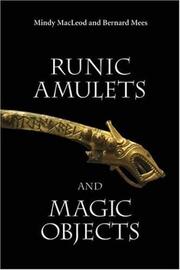| Listing 1 - 2 of 2 |
Sort by
|

ISBN: 1846155045 1843832054 Year: 2006 Publisher: Woodbridge : Boydell,
Abstract | Keywords | Export | Availability | Bookmark
 Loading...
Loading...Choose an application
- Reference Manager
- EndNote
- RefWorks (Direct export to RefWorks)
A fresh examination of one of the most contentious issues in runic scholarship - magical or not? The runic alphabet, in use for well over a thousand years, was employed by various Germanic groups in a variety of ways, including, inevitably, for superstitious and magical rites. Formulaic runic words were inscribed onto small items that could be carried for good luck; runic charms were carved on metal or wooden amulets to ensure peace or prosperity. There are invocations and allusions to pagan and Christian gods and heroes, to spirits of disease, and even to potential lovers. Few such texts are completely unique to Germanic society, and in fact, most of the runic amulets considered in this book show wide-ranging parallels from a variety of European cultures. The question of whether runes were magical or not has divided scholarship in the area. Early criticism embraced fantastic notions of runic magic - leading not just to a healthy scepticism, but in some cases to a complete denial of any magical element whatsoever in the runic inscriptions. This book seeks to re-evaulate the whole question of runic sorcery, attested to not only in the medieval Norse literature dealing with runes but primarily in the fascinating magical texts of the runic inscriptions themselves. Dr MINDY MCLEOD teaches in the Department of Linguistics, Deakin University, Melbourne; Dr BERNARD MEES teaches in the Department of History at the University of Melbourne.
Runes. --- Amulets. --- Magic. --- Inscriptions, Runic. --- Runic inscriptions --- Inscriptions, Norse --- Runes --- Magick --- Necromancy --- Sorcery --- Spells --- Occultism --- Archaeology --- Demonology --- Magic --- Superstition --- Witchcraft --- Charms --- Talismans --- Futhark --- Futhorc --- Futhork --- Runic alphabets --- Alphabet --- Paleography --- Inscriptions, Runic --- Germanic Groups. --- Magic Objects. --- Magical Inscriptions. --- Magical Texts. --- Medieval Norse Literature. --- Runic Alphabet. --- Runic Amulets. --- Superstitious Rites.
Book
ISBN: 140088800X Year: 2017 Publisher: Princeton, NJ : Princeton University Press,
Abstract | Keywords | Export | Availability | Bookmark
 Loading...
Loading...Choose an application
- Reference Manager
- EndNote
- RefWorks (Direct export to RefWorks)
How does a culture become Christian, especially one that is heir to such ancient traditions and spectacular monuments as Egypt? This book offers a new model for envisioning the process of Christianization by looking at the construction of Christianity in the various social and creative worlds active in Egyptian culture during late antiquity.As David Frankfurter shows, members of these different social and creative worlds came to create different forms of Christianity according to their specific interests, their traditional idioms, and their sense of what the religion could offer. Reintroducing the term "syncretism" for the inevitable and continuous process by which a religion is acculturated, the book addresses the various formations of Egyptian Christianity that developed in the domestic sphere, the worlds of holy men and saints' shrines, the work of craftsmen and artisans, the culture of monastic scribes, and the reimagination of the landscape itself, through processions, architecture, and the potent remains of the past.Drawing on sermons and magical texts, saints' lives and figurines, letters and amulets, and comparisons with Christianization elsewhere in the Roman empire and beyond, Christianizing Egypt reconceives religious change-from the "conversion" of hearts and minds to the selective incorporation and application of strategies for protection, authority, and efficacy, and for imagining the environment.
Syncretism (Religion) --- Christianity and other religions --- Egyptian. --- Egypt --- Religion --- Acolyte. --- Amulet. --- Ancient Egypt. --- Ancient Egyptian deities. --- Apocalypse of Elijah. --- Apotropaic magic. --- Archaeology. --- Basilica. --- Burial. --- Caesarius of Arles. --- Cemetery. --- Ceremony. --- Christian art. --- Christian demonology. --- Christian media. --- Christian monasticism. --- Christian theology. --- Christian tradition. --- Christianity. --- Christianization. --- Clergy. --- Deity. --- Demonization. --- Demonology. --- Divination. --- Epigraphy. --- Exorcism. --- Figurine. --- God. --- Hagiography. --- Harpocrates. --- Heathenry (new religious movement). --- Homily. --- Household. --- Iconography. --- Ideology. --- Image of God. --- Incense. --- Jews. --- John Chrysostom. --- Laity. --- Late Antiquity. --- Literature. --- Liturgy. --- Lord's Prayer. --- Magical texts. --- Mamre. --- Martin Classical Lectures. --- Martyr. --- Menouthis. --- Michael (archangel). --- Modernity. --- Monastery. --- Monasticism. --- Mummy. --- Mural. --- Names of God in Judaism. --- Narrative. --- New Christian. --- Nomina sacra. --- Oberlin College. --- Orthodoxy. --- Oxyrhynchus. --- Paganism. --- Piety. --- Pottery. --- Prayer. --- Procession. --- Prophets of Christianity. --- Relic. --- Religion. --- Religious conversion. --- Religious identity. --- Religious order. --- Religious orientation. --- Religious text. --- Reuse. --- Rite. --- Roman Empire. --- Routledge. --- Saint. --- Sermon. --- Shai. --- Shenoute. --- Shrine. --- Stele. --- Syncretism. --- Terracotta. --- The Monastery. --- The Various. --- Theocracy. --- Tomb. --- Tradition. --- Upper Egypt. --- V. --- Veneration. --- Votive offering. --- Worship. --- Wreath. --- Writing.
| Listing 1 - 2 of 2 |
Sort by
|

 Search
Search Feedback
Feedback About UniCat
About UniCat  Help
Help News
News